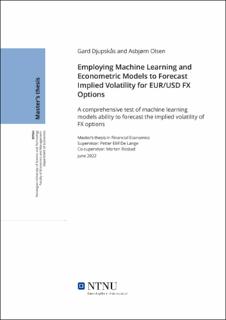| dc.contributor.advisor | De Lange, Petter Eilif | |
| dc.contributor.advisor | Risstad, Morten | |
| dc.contributor.author | Djupskås, Gard | |
| dc.contributor.author | Olsen, Asbjørn | |
| dc.date.accessioned | 2022-07-15T17:20:44Z | |
| dc.date.issued | 2022 | |
| dc.identifier | no.ntnu:inspera:114729398:70122681 | |
| dc.identifier.uri | https://hdl.handle.net/11250/3005929 | |
| dc.description.abstract | I denne artikkelen gjennomfører vi en empirisk studie av prognosenøyaktigheten til LSTM-, Random Forest- og AR-GARCH-modeller for implisitt volatilitet på daglige spotkurser for EUR/USD-valutaopsjoner. Vi bruker en univariate tidsserier med implisitt volatilitet som variabler og sammenligner prognosenøyaktigheten på tvers av modellene med de statistiske målemetodene kvadratisk gjennomsnittsfeil, rot av kvadratisk gjennomsnittsfeil og absolutt gjennomsnittsfeil. I tillegg, gjennomfører vi en Diebold-Mariano-test for å undersøke om forskjellene mellom modellene er statistisk signifikant. Vi benytter Random Forest og AR(1)-GARCH(1,1) med normalfordelte restledd som referansemodeller for den mer avanserte LSTM modellen. Utover AR(1)-GARCH(1,1) utvider vi analysen med økonometriske modeller som inkluderer asymmetriske variabler, MA-variabler, sammen med normalfordelte og t-fordelte restledd. Våre funn konkluderer med at LSTM modellen er bedre enn referansemodellene for opsjoner med korte løpetider, og AR-GARCH er bedre for lengre løpetider. Videre finner vi at AR-GARCH-rammeverket er bedre enn de mer avanserte maskinlæringsmodellene når vi utvider modellene med andre spesifikasjoner og restledd distribusjoner. For kortere løpetider er t-fordelte restledd best, mens ARIMA-GARCH modeller er bedre for lengre løpetider. Valutaopsjoners implisitte volatilitet, og herved denne artikkelen, er av interesse for alle markedsaktører som er eksponert for valutarisiko, for sikring og spekulative formål. | |
| dc.description.abstract | In this paper we propose an empirical study of the forecasting performance of LSTM, Random Forest and AR-GARCH models on daily spot rates of implied volatility for EUR/USD exchange rate options. We apply a univariate time series of implied volatility as explanatory variables to forecast out-of-sample predictions for implied volatility, and compare the forecast performance across models based on the statistical error measurements mean squared error, root mean squared error and mean absolute error. Additionally, we conduct a Diebold-Mariano test to question the statistical differences between the models. We impose Random Forest and a Gaussian distributed AR(1)-GARCH(1,1) as benchmark models and compare their forecasting performance to the more advanced LSTM model. In addition to the benchmark AR(1)-GARCH(1,1) model, we extend the analysis with models that include an asymmetric GARCH term, moving average terms, along with Gaussian distributed residuals and Student t-distributed residuals. Our findings conclude that the LSTM model is better than the benchmark models for shorter option maturities, whilst the AR-GARCH model is superior when the maturities increase. However, when imposing other specifications and residual distribution for the GARCH models, we find that the AR-GARCH framework outperforms the more advanced machine learning models for all options. For shorter maturities the t- distributed models perform best, while ARIMA-GARCH-type models perform better for longer maturities. Implied volatility of FX options, and hereby this paper, are of interest to all market participants that are exposed to foreign exchange risk, for hedging and trading purposes. | |
| dc.language | eng | |
| dc.publisher | NTNU | |
| dc.title | Employing Machine Learning and Econometric Models to Forecast Implied Volatility for EUR/USD FX Options | |
| dc.type | Master thesis | |
